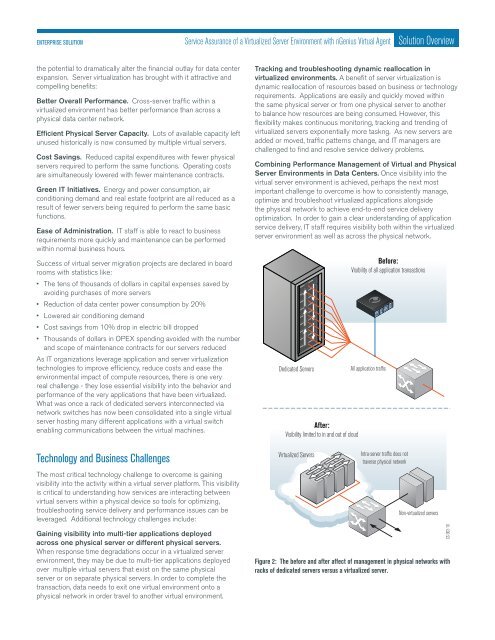Service Assurance of a Virtualized Server Environment with - NetScout
Service Assurance of a Virtualized Server Environment with - NetScout
Service Assurance of a Virtualized Server Environment with - NetScout
Create successful ePaper yourself
Turn your PDF publications into a flip-book with our unique Google optimized e-Paper software.
ENTERPRISE SOLUTION <strong>Service</strong> <strong>Assurance</strong> <strong>of</strong> a <strong>Virtualized</strong> <strong>Server</strong> <strong>Environment</strong> <strong>with</strong> nGenius Virtual Agent Solution Overview<br />
the potential to dramatically alter the financial outlay for data center<br />
expansion. <strong>Server</strong> virtualization has brought <strong>with</strong> it attractive and<br />
compelling benefits:<br />
Better Overall Performance. Cross-server traffic <strong>with</strong>in a<br />
virtualized environment has better performance than across a<br />
physical data center network.<br />
Efficient Physical <strong>Server</strong> Capacity. Lots <strong>of</strong> available capacity left<br />
unused historically is now consumed by multiple virtual servers.<br />
Cost Savings. Reduced capital expenditures <strong>with</strong> fewer physical<br />
servers required to perform the same functions. Operating costs<br />
are simultaneously lowered <strong>with</strong> fewer maintenance contracts.<br />
Green IT Initiatives. Energy and power consumption, air<br />
conditioning demand and real estate footprint are all reduced as a<br />
result <strong>of</strong> fewer servers being required to perform the same basic<br />
functions.<br />
Ease <strong>of</strong> Administration. IT staff is able to react to business<br />
requirements more quickly and maintenance can be performed<br />
<strong>with</strong>in normal business hours.<br />
Success <strong>of</strong> virtual server migration projects are declared in board<br />
rooms <strong>with</strong> statistics like:<br />
• The tens <strong>of</strong> thousands <strong>of</strong> dollars in capital expenses saved by<br />
avoiding purchases <strong>of</strong> more servers<br />
• Reduction <strong>of</strong> data center power consumption by 20%<br />
• Lowered air conditioning demand<br />
• Cost savings from 10% drop in electric bill dropped<br />
• Thousands <strong>of</strong> dollars in OPEX spending avoided <strong>with</strong> the number<br />
and scope <strong>of</strong> maintenance contracts for our servers reduced<br />
As IT organizations leverage application and server virtualization<br />
technologies to improve efficiency, reduce costs and ease the<br />
environmental impact <strong>of</strong> compute resources, there is one very<br />
real challenge - they lose essential visibility into the behavior and<br />
performance <strong>of</strong> the very applications that have been virtualized.<br />
What was once a rack <strong>of</strong> dedicated servers interconnected via<br />
network switches has now been consolidated into a single virtual<br />
server hosting many different applications <strong>with</strong> a virtual switch<br />
enabling communications between the virtual machines.<br />
Technology and Business Challenges<br />
The most critical technology challenge to overcome is gaining<br />
visibility into the activity <strong>with</strong>in a virtual server platform. This visibility<br />
is critical to understanding how services are interacting between<br />
virtual servers <strong>with</strong>in a physical device so tools for optimizing,<br />
troubleshooting service delivery and performance issues can be<br />
leveraged. Additional technology challenges include:<br />
Gaining visibility into multi-tier applications deployed<br />
across one physical server or different physical servers.<br />
When response time degradations occur in a virtualized server<br />
environment, they may be due to multi-tier applications deployed<br />
over multiple virtual servers that exist on the same physical<br />
server or on separate physical servers. In order to complete the<br />
transaction, data needs to exit one virtual environment onto a<br />
physical network in order travel to another virtual environment.<br />
Tracking and troubleshooting dynamic reallocation in<br />
virtualized environments. A benefit <strong>of</strong> server virtualization is<br />
dynamic reallocation <strong>of</strong> resources based on business or technology<br />
requirements. Applications are easily and quickly moved <strong>with</strong>in<br />
the same physical server or from one physical server to another<br />
to balance how resources are being consumed. However, this<br />
flexibility makes continuous monitoring, tracking and trending <strong>of</strong><br />
virtualized servers exponentially more taskng. As new servers are<br />
added or moved, traffic patterns change, and IT managers are<br />
challenged to find and resolve service delivery problems.<br />
Combining Performance Management <strong>of</strong> Virtual and Physical<br />
<strong>Server</strong> <strong>Environment</strong>s in Data Centers. Once visibility into the<br />
virtual server environment is achieved, perhaps the next most<br />
important challenge to overcome is how to consistently manage,<br />
optimize and troubleshoot virtualized applications alongside<br />
the physical network to achieve end-to-end service delivery<br />
optimization. In order to gain a clear understanding <strong>of</strong> application<br />
service delivery, IT staff requires visibility both <strong>with</strong>in the virtualized<br />
server environment as well as across the physical network.<br />
Dedicated <strong>Server</strong>s<br />
After:<br />
Visibility limited to in and out <strong>of</strong> cloud<br />
<strong>Virtualized</strong> <strong>Server</strong>s<br />
Before:<br />
Visibility <strong>of</strong> all application transactions<br />
All application traffic<br />
Intra-server traffic does not<br />
traverse physical network<br />
Non-virtualized servers<br />
Figure 2: The before and after affect <strong>of</strong> management in physical networks <strong>with</strong><br />
racks <strong>of</strong> dedicated servers versus a virtualized server.<br />
CS-002-10

















